Business Environment Analysis: Essay, Case Study of UK Supermarkets
VerifiedAdded on 2020/10/22
|12
|4436
|330
Report
AI Summary
This report provides a comprehensive analysis of the business environment, encompassing an essay that critically examines various organizational types (profit, non-profit, etc.) based on their purpose, size, and scope, and how business functions relate to organizational missions and objectives. The report also includes a detailed case study focusing on the UK supermarket sector. This case study utilizes SWOT and PESTLE analyses to evaluate the internal and external business environments, and applies Porter's Five Forces model to analyze competitive forces within the sector. The essay delves into the factors shaping the business environment, including internal and external influences, and the importance of understanding these factors for organizational success. The report covers organizational structures, business functions (marketing, finance, HR, and operations), and their interrelationships. The case study examines the impact of political factors, such as Brexit, on the UK supermarket sector. The paper also touches upon the different types of organizations like profit, non-profit, and non-governmental firms and their structures.
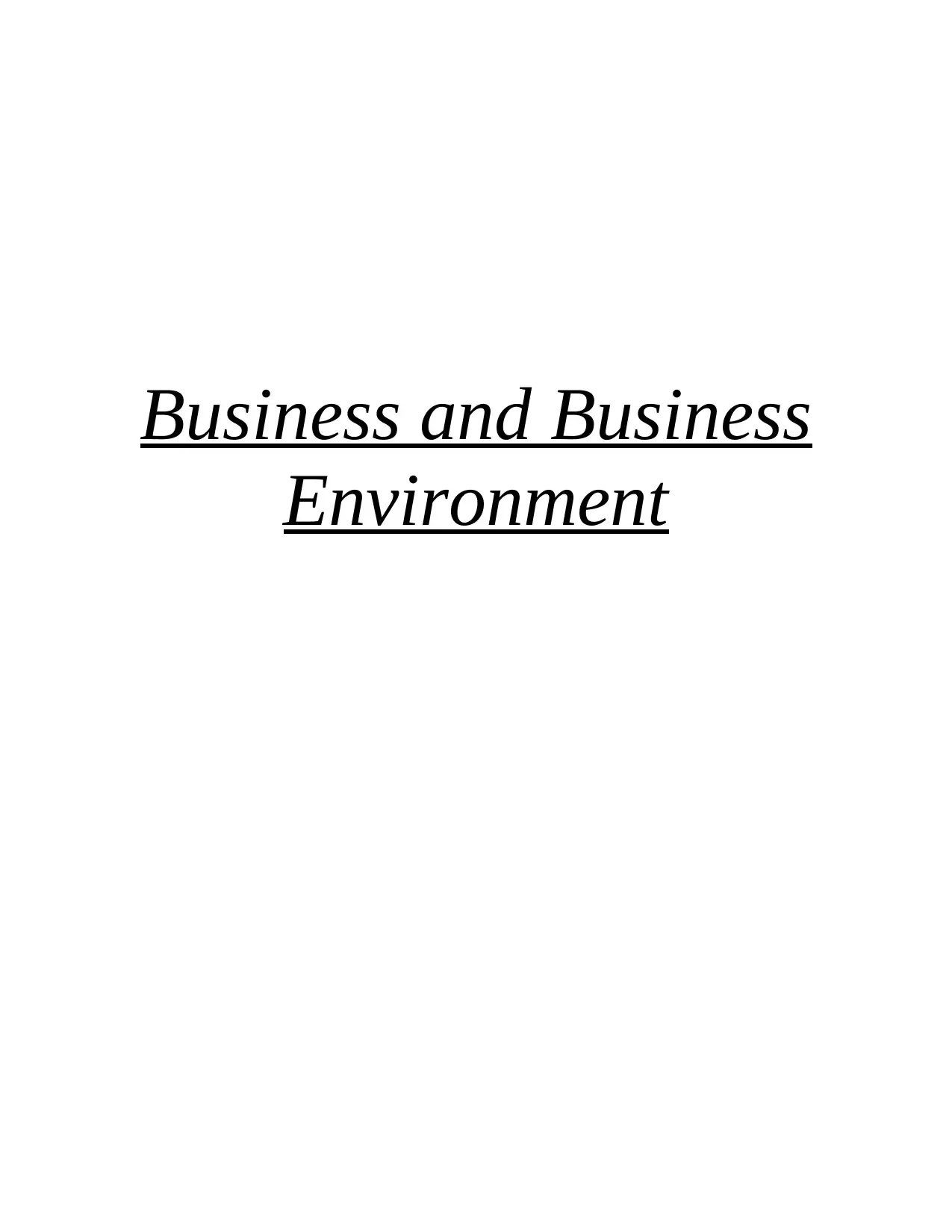
Business and Business
Environment
Environment
Paraphrase This Document
Need a fresh take? Get an instant paraphrase of this document with our AI Paraphraser
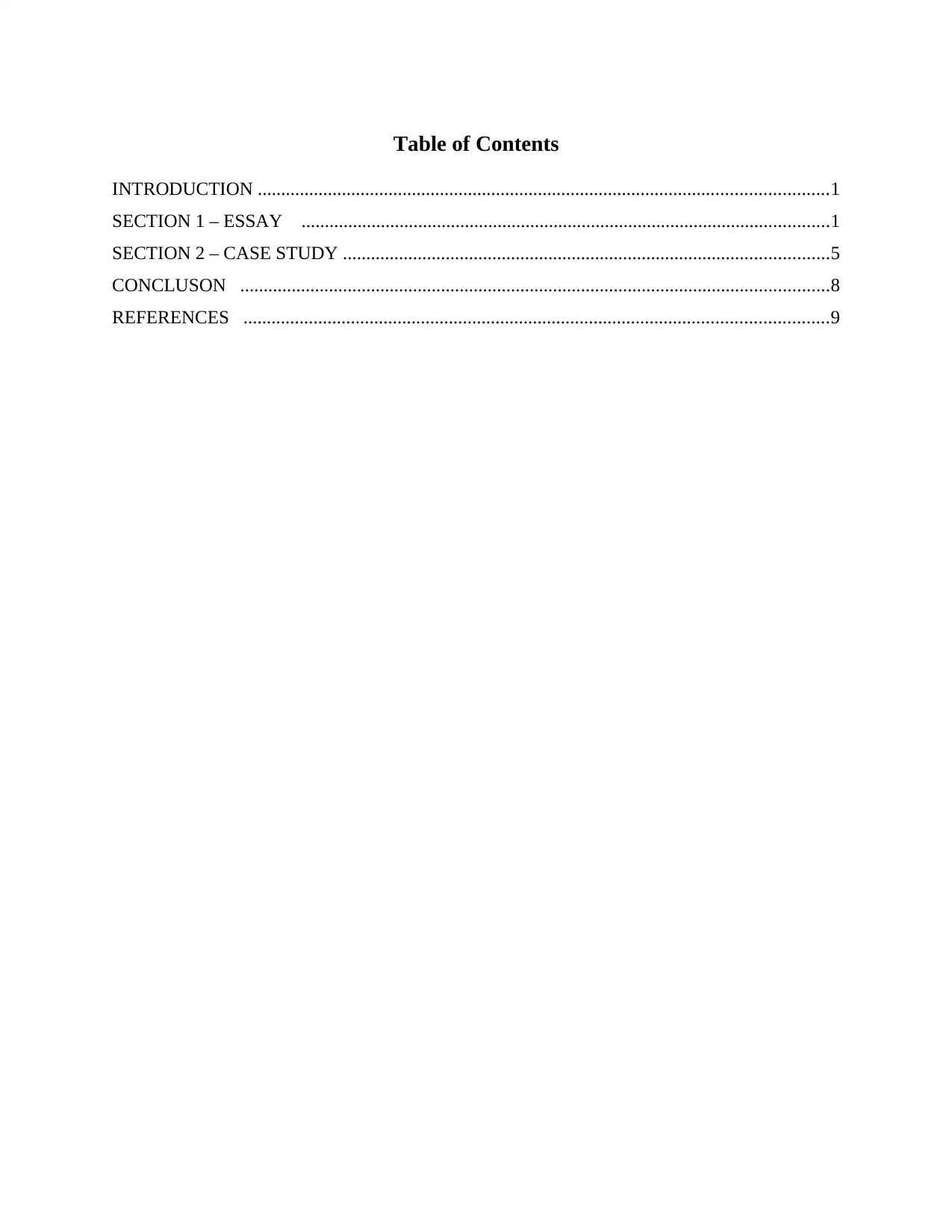
Table of Contents
INTRODUCTION ..........................................................................................................................1
SECTION 1 – ESSAY .................................................................................................................1
SECTION 2 – CASE STUDY ........................................................................................................5
CONCLUSON ..............................................................................................................................8
REFERENCES .............................................................................................................................9
INTRODUCTION ..........................................................................................................................1
SECTION 1 – ESSAY .................................................................................................................1
SECTION 2 – CASE STUDY ........................................................................................................5
CONCLUSON ..............................................................................................................................8
REFERENCES .............................................................................................................................9
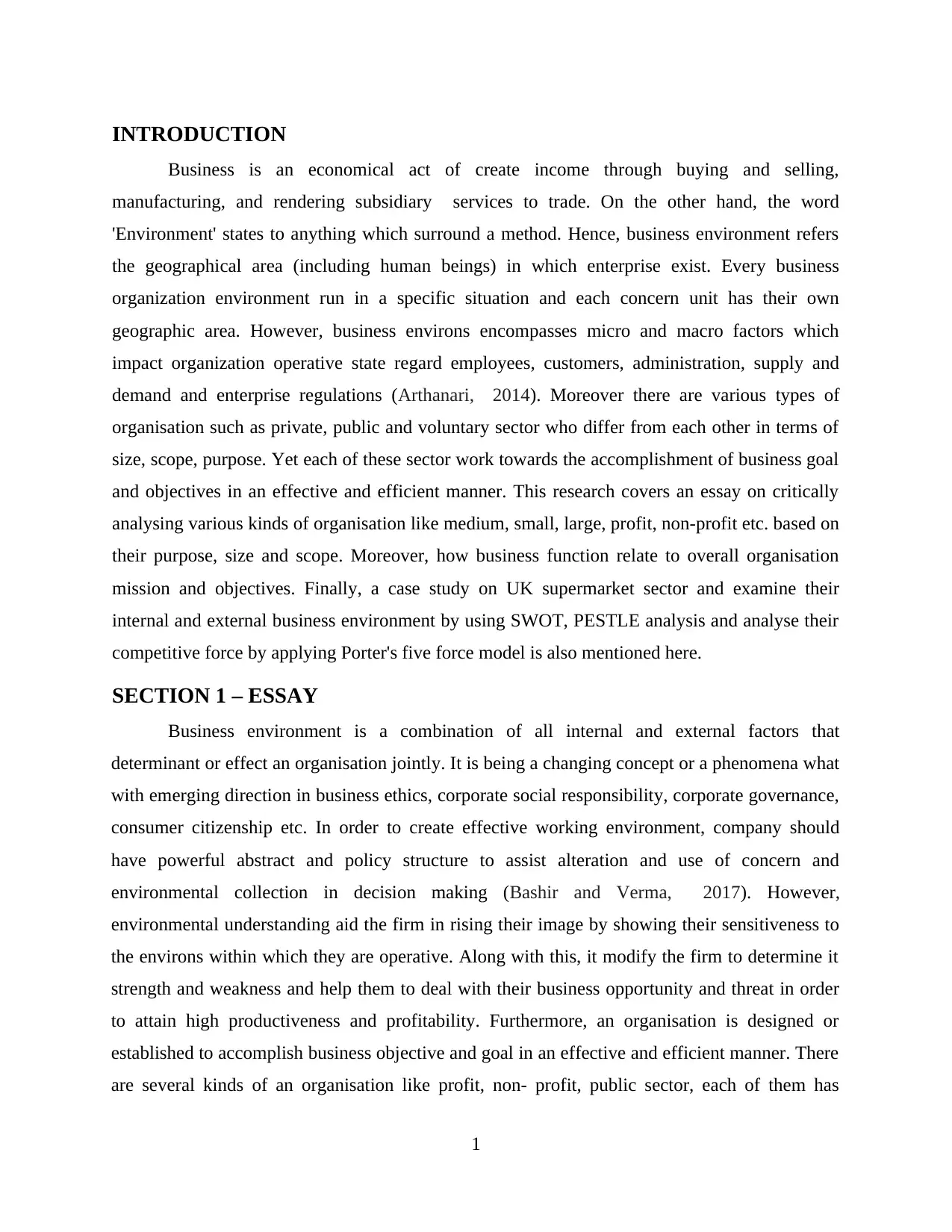
INTRODUCTION
Business is an economical act of create income through buying and selling,
manufacturing, and rendering subsidiary services to trade. On the other hand, the word
'Environment' states to anything which surround a method. Hence, business environment refers
the geographical area (including human beings) in which enterprise exist. Every business
organization environment run in a specific situation and each concern unit has their own
geographic area. However, business environs encompasses micro and macro factors which
impact organization operative state regard employees, customers, administration, supply and
demand and enterprise regulations (Arthanari, 2014). Moreover there are various types of
organisation such as private, public and voluntary sector who differ from each other in terms of
size, scope, purpose. Yet each of these sector work towards the accomplishment of business goal
and objectives in an effective and efficient manner. This research covers an essay on critically
analysing various kinds of organisation like medium, small, large, profit, non-profit etc. based on
their purpose, size and scope. Moreover, how business function relate to overall organisation
mission and objectives. Finally, a case study on UK supermarket sector and examine their
internal and external business environment by using SWOT, PESTLE analysis and analyse their
competitive force by applying Porter's five force model is also mentioned here.
SECTION 1 – ESSAY
Business environment is a combination of all internal and external factors that
determinant or effect an organisation jointly. It is being a changing concept or a phenomena what
with emerging direction in business ethics, corporate social responsibility, corporate governance,
consumer citizenship etc. In order to create effective working environment, company should
have powerful abstract and policy structure to assist alteration and use of concern and
environmental collection in decision making (Bashir and Verma, 2017). However,
environmental understanding aid the firm in rising their image by showing their sensitiveness to
the environs within which they are operative. Along with this, it modify the firm to determine it
strength and weakness and help them to deal with their business opportunity and threat in order
to attain high productiveness and profitability. Furthermore, an organisation is designed or
established to accomplish business objective and goal in an effective and efficient manner. There
are several kinds of an organisation like profit, non- profit, public sector, each of them has
1
Business is an economical act of create income through buying and selling,
manufacturing, and rendering subsidiary services to trade. On the other hand, the word
'Environment' states to anything which surround a method. Hence, business environment refers
the geographical area (including human beings) in which enterprise exist. Every business
organization environment run in a specific situation and each concern unit has their own
geographic area. However, business environs encompasses micro and macro factors which
impact organization operative state regard employees, customers, administration, supply and
demand and enterprise regulations (Arthanari, 2014). Moreover there are various types of
organisation such as private, public and voluntary sector who differ from each other in terms of
size, scope, purpose. Yet each of these sector work towards the accomplishment of business goal
and objectives in an effective and efficient manner. This research covers an essay on critically
analysing various kinds of organisation like medium, small, large, profit, non-profit etc. based on
their purpose, size and scope. Moreover, how business function relate to overall organisation
mission and objectives. Finally, a case study on UK supermarket sector and examine their
internal and external business environment by using SWOT, PESTLE analysis and analyse their
competitive force by applying Porter's five force model is also mentioned here.
SECTION 1 – ESSAY
Business environment is a combination of all internal and external factors that
determinant or effect an organisation jointly. It is being a changing concept or a phenomena what
with emerging direction in business ethics, corporate social responsibility, corporate governance,
consumer citizenship etc. In order to create effective working environment, company should
have powerful abstract and policy structure to assist alteration and use of concern and
environmental collection in decision making (Bashir and Verma, 2017). However,
environmental understanding aid the firm in rising their image by showing their sensitiveness to
the environs within which they are operative. Along with this, it modify the firm to determine it
strength and weakness and help them to deal with their business opportunity and threat in order
to attain high productiveness and profitability. Furthermore, an organisation is designed or
established to accomplish business objective and goal in an effective and efficient manner. There
are several kinds of an organisation like profit, non- profit, public sector, each of them has
1
⊘ This is a preview!⊘
Do you want full access?
Subscribe today to unlock all pages.

Trusted by 1+ million students worldwide
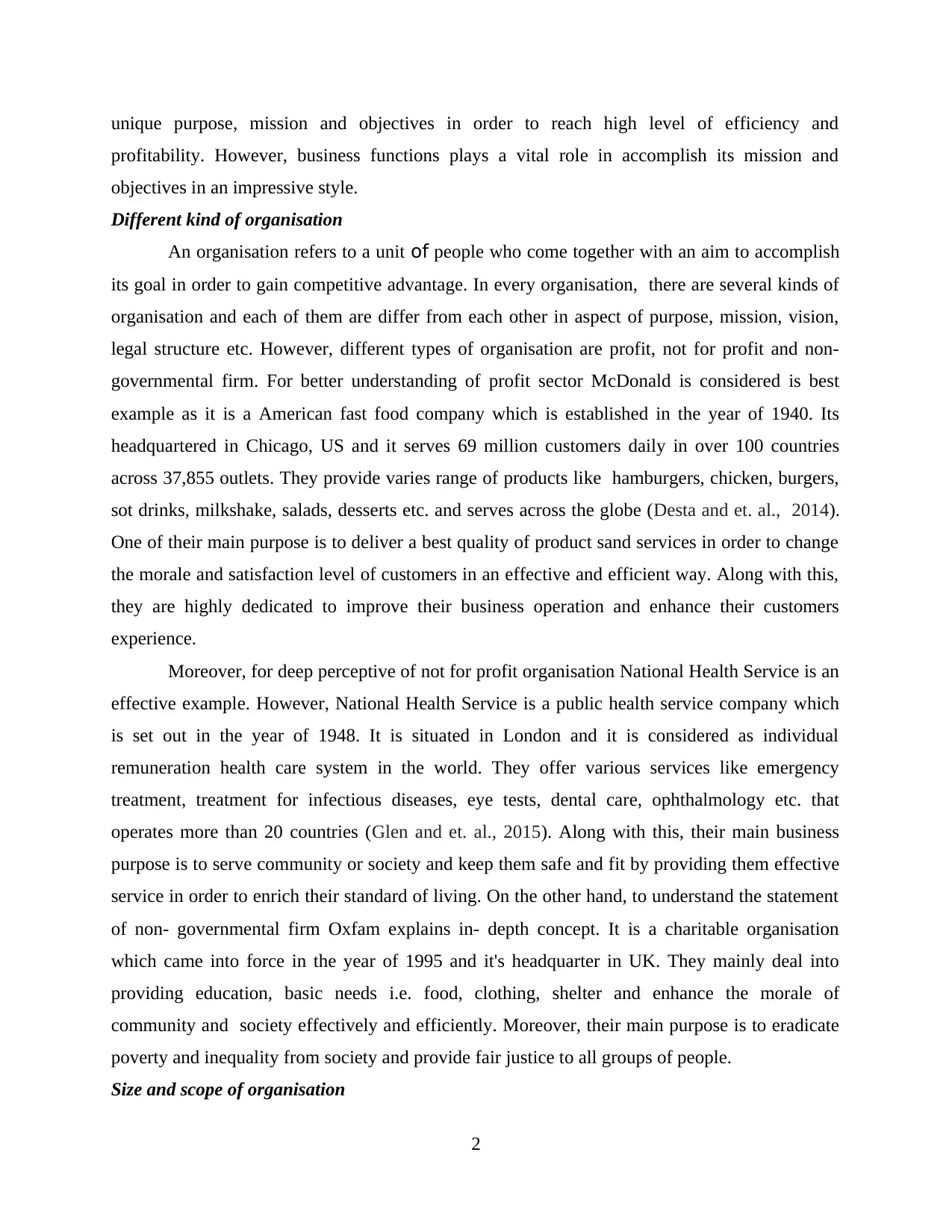
unique purpose, mission and objectives in order to reach high level of efficiency and
profitability. However, business functions plays a vital role in accomplish its mission and
objectives in an impressive style.
Different kind of organisation
An organisation refers to a unit of people who come together with an aim to accomplish
its goal in order to gain competitive advantage. In every organisation, there are several kinds of
organisation and each of them are differ from each other in aspect of purpose, mission, vision,
legal structure etc. However, different types of organisation are profit, not for profit and non-
governmental firm. For better understanding of profit sector McDonald is considered is best
example as it is a American fast food company which is established in the year of 1940. Its
headquartered in Chicago, US and it serves 69 million customers daily in over 100 countries
across 37,855 outlets. They provide varies range of products like hamburgers, chicken, burgers,
sot drinks, milkshake, salads, desserts etc. and serves across the globe (Desta and et. al., 2014).
One of their main purpose is to deliver a best quality of product sand services in order to change
the morale and satisfaction level of customers in an effective and efficient way. Along with this,
they are highly dedicated to improve their business operation and enhance their customers
experience.
Moreover, for deep perceptive of not for profit organisation National Health Service is an
effective example. However, National Health Service is a public health service company which
is set out in the year of 1948. It is situated in London and it is considered as individual
remuneration health care system in the world. They offer various services like emergency
treatment, treatment for infectious diseases, eye tests, dental care, ophthalmology etc. that
operates more than 20 countries (Glen and et. al., 2015). Along with this, their main business
purpose is to serve community or society and keep them safe and fit by providing them effective
service in order to enrich their standard of living. On the other hand, to understand the statement
of non- governmental firm Oxfam explains in- depth concept. It is a charitable organisation
which came into force in the year of 1995 and it's headquarter in UK. They mainly deal into
providing education, basic needs i.e. food, clothing, shelter and enhance the morale of
community and society effectively and efficiently. Moreover, their main purpose is to eradicate
poverty and inequality from society and provide fair justice to all groups of people.
Size and scope of organisation
2
profitability. However, business functions plays a vital role in accomplish its mission and
objectives in an impressive style.
Different kind of organisation
An organisation refers to a unit of people who come together with an aim to accomplish
its goal in order to gain competitive advantage. In every organisation, there are several kinds of
organisation and each of them are differ from each other in aspect of purpose, mission, vision,
legal structure etc. However, different types of organisation are profit, not for profit and non-
governmental firm. For better understanding of profit sector McDonald is considered is best
example as it is a American fast food company which is established in the year of 1940. Its
headquartered in Chicago, US and it serves 69 million customers daily in over 100 countries
across 37,855 outlets. They provide varies range of products like hamburgers, chicken, burgers,
sot drinks, milkshake, salads, desserts etc. and serves across the globe (Desta and et. al., 2014).
One of their main purpose is to deliver a best quality of product sand services in order to change
the morale and satisfaction level of customers in an effective and efficient way. Along with this,
they are highly dedicated to improve their business operation and enhance their customers
experience.
Moreover, for deep perceptive of not for profit organisation National Health Service is an
effective example. However, National Health Service is a public health service company which
is set out in the year of 1948. It is situated in London and it is considered as individual
remuneration health care system in the world. They offer various services like emergency
treatment, treatment for infectious diseases, eye tests, dental care, ophthalmology etc. that
operates more than 20 countries (Glen and et. al., 2015). Along with this, their main business
purpose is to serve community or society and keep them safe and fit by providing them effective
service in order to enrich their standard of living. On the other hand, to understand the statement
of non- governmental firm Oxfam explains in- depth concept. It is a charitable organisation
which came into force in the year of 1995 and it's headquarter in UK. They mainly deal into
providing education, basic needs i.e. food, clothing, shelter and enhance the morale of
community and society effectively and efficiently. Moreover, their main purpose is to eradicate
poverty and inequality from society and provide fair justice to all groups of people.
Size and scope of organisation
2
Paraphrase This Document
Need a fresh take? Get an instant paraphrase of this document with our AI Paraphraser
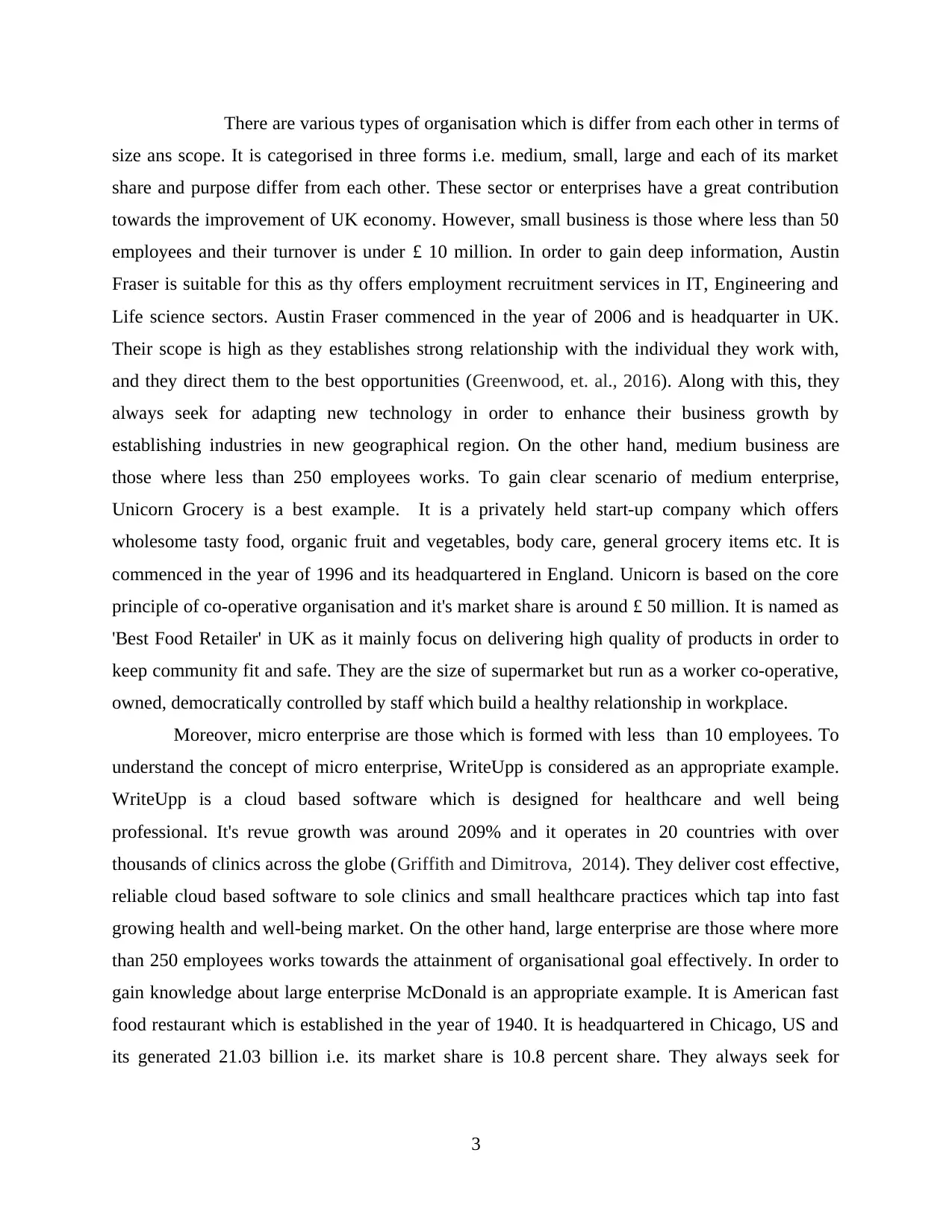
There are various types of organisation which is differ from each other in terms of
size ans scope. It is categorised in three forms i.e. medium, small, large and each of its market
share and purpose differ from each other. These sector or enterprises have a great contribution
towards the improvement of UK economy. However, small business is those where less than 50
employees and their turnover is under £ 10 million. In order to gain deep information, Austin
Fraser is suitable for this as thy offers employment recruitment services in IT, Engineering and
Life science sectors. Austin Fraser commenced in the year of 2006 and is headquarter in UK.
Their scope is high as they establishes strong relationship with the individual they work with,
and they direct them to the best opportunities (Greenwood, et. al., 2016). Along with this, they
always seek for adapting new technology in order to enhance their business growth by
establishing industries in new geographical region. On the other hand, medium business are
those where less than 250 employees works. To gain clear scenario of medium enterprise,
Unicorn Grocery is a best example. It is a privately held start-up company which offers
wholesome tasty food, organic fruit and vegetables, body care, general grocery items etc. It is
commenced in the year of 1996 and its headquartered in England. Unicorn is based on the core
principle of co-operative organisation and it's market share is around £ 50 million. It is named as
'Best Food Retailer' in UK as it mainly focus on delivering high quality of products in order to
keep community fit and safe. They are the size of supermarket but run as a worker co-operative,
owned, democratically controlled by staff which build a healthy relationship in workplace.
Moreover, micro enterprise are those which is formed with less than 10 employees. To
understand the concept of micro enterprise, WriteUpp is considered as an appropriate example.
WriteUpp is a cloud based software which is designed for healthcare and well being
professional. It's revue growth was around 209% and it operates in 20 countries with over
thousands of clinics across the globe (Griffith and Dimitrova, 2014). They deliver cost effective,
reliable cloud based software to sole clinics and small healthcare practices which tap into fast
growing health and well-being market. On the other hand, large enterprise are those where more
than 250 employees works towards the attainment of organisational goal effectively. In order to
gain knowledge about large enterprise McDonald is an appropriate example. It is American fast
food restaurant which is established in the year of 1940. It is headquartered in Chicago, US and
its generated 21.03 billion i.e. its market share is 10.8 percent share. They always seek for
3
size ans scope. It is categorised in three forms i.e. medium, small, large and each of its market
share and purpose differ from each other. These sector or enterprises have a great contribution
towards the improvement of UK economy. However, small business is those where less than 50
employees and their turnover is under £ 10 million. In order to gain deep information, Austin
Fraser is suitable for this as thy offers employment recruitment services in IT, Engineering and
Life science sectors. Austin Fraser commenced in the year of 2006 and is headquarter in UK.
Their scope is high as they establishes strong relationship with the individual they work with,
and they direct them to the best opportunities (Greenwood, et. al., 2016). Along with this, they
always seek for adapting new technology in order to enhance their business growth by
establishing industries in new geographical region. On the other hand, medium business are
those where less than 250 employees works. To gain clear scenario of medium enterprise,
Unicorn Grocery is a best example. It is a privately held start-up company which offers
wholesome tasty food, organic fruit and vegetables, body care, general grocery items etc. It is
commenced in the year of 1996 and its headquartered in England. Unicorn is based on the core
principle of co-operative organisation and it's market share is around £ 50 million. It is named as
'Best Food Retailer' in UK as it mainly focus on delivering high quality of products in order to
keep community fit and safe. They are the size of supermarket but run as a worker co-operative,
owned, democratically controlled by staff which build a healthy relationship in workplace.
Moreover, micro enterprise are those which is formed with less than 10 employees. To
understand the concept of micro enterprise, WriteUpp is considered as an appropriate example.
WriteUpp is a cloud based software which is designed for healthcare and well being
professional. It's revue growth was around 209% and it operates in 20 countries with over
thousands of clinics across the globe (Griffith and Dimitrova, 2014). They deliver cost effective,
reliable cloud based software to sole clinics and small healthcare practices which tap into fast
growing health and well-being market. On the other hand, large enterprise are those where more
than 250 employees works towards the attainment of organisational goal effectively. In order to
gain knowledge about large enterprise McDonald is an appropriate example. It is American fast
food restaurant which is established in the year of 1940. It is headquartered in Chicago, US and
its generated 21.03 billion i.e. its market share is 10.8 percent share. They always seek for
3
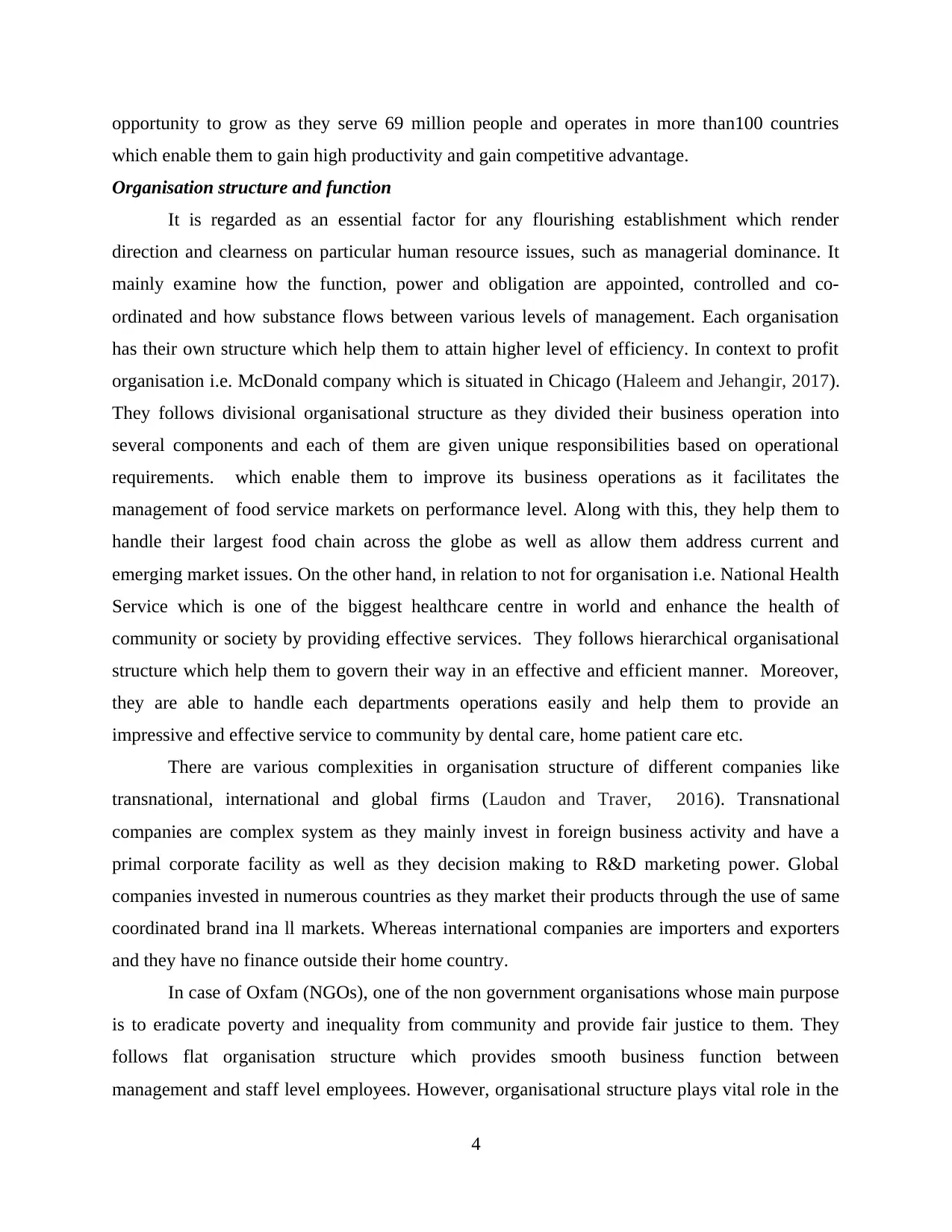
opportunity to grow as they serve 69 million people and operates in more than100 countries
which enable them to gain high productivity and gain competitive advantage.
Organisation structure and function
It is regarded as an essential factor for any flourishing establishment which render
direction and clearness on particular human resource issues, such as managerial dominance. It
mainly examine how the function, power and obligation are appointed, controlled and co-
ordinated and how substance flows between various levels of management. Each organisation
has their own structure which help them to attain higher level of efficiency. In context to profit
organisation i.e. McDonald company which is situated in Chicago (Haleem and Jehangir, 2017).
They follows divisional organisational structure as they divided their business operation into
several components and each of them are given unique responsibilities based on operational
requirements. which enable them to improve its business operations as it facilitates the
management of food service markets on performance level. Along with this, they help them to
handle their largest food chain across the globe as well as allow them address current and
emerging market issues. On the other hand, in relation to not for organisation i.e. National Health
Service which is one of the biggest healthcare centre in world and enhance the health of
community or society by providing effective services. They follows hierarchical organisational
structure which help them to govern their way in an effective and efficient manner. Moreover,
they are able to handle each departments operations easily and help them to provide an
impressive and effective service to community by dental care, home patient care etc.
There are various complexities in organisation structure of different companies like
transnational, international and global firms (Laudon and Traver, 2016). Transnational
companies are complex system as they mainly invest in foreign business activity and have a
primal corporate facility as well as they decision making to R&D marketing power. Global
companies invested in numerous countries as they market their products through the use of same
coordinated brand ina ll markets. Whereas international companies are importers and exporters
and they have no finance outside their home country.
In case of Oxfam (NGOs), one of the non government organisations whose main purpose
is to eradicate poverty and inequality from community and provide fair justice to them. They
follows flat organisation structure which provides smooth business function between
management and staff level employees. However, organisational structure plays vital role in the
4
which enable them to gain high productivity and gain competitive advantage.
Organisation structure and function
It is regarded as an essential factor for any flourishing establishment which render
direction and clearness on particular human resource issues, such as managerial dominance. It
mainly examine how the function, power and obligation are appointed, controlled and co-
ordinated and how substance flows between various levels of management. Each organisation
has their own structure which help them to attain higher level of efficiency. In context to profit
organisation i.e. McDonald company which is situated in Chicago (Haleem and Jehangir, 2017).
They follows divisional organisational structure as they divided their business operation into
several components and each of them are given unique responsibilities based on operational
requirements. which enable them to improve its business operations as it facilitates the
management of food service markets on performance level. Along with this, they help them to
handle their largest food chain across the globe as well as allow them address current and
emerging market issues. On the other hand, in relation to not for organisation i.e. National Health
Service which is one of the biggest healthcare centre in world and enhance the health of
community or society by providing effective services. They follows hierarchical organisational
structure which help them to govern their way in an effective and efficient manner. Moreover,
they are able to handle each departments operations easily and help them to provide an
impressive and effective service to community by dental care, home patient care etc.
There are various complexities in organisation structure of different companies like
transnational, international and global firms (Laudon and Traver, 2016). Transnational
companies are complex system as they mainly invest in foreign business activity and have a
primal corporate facility as well as they decision making to R&D marketing power. Global
companies invested in numerous countries as they market their products through the use of same
coordinated brand ina ll markets. Whereas international companies are importers and exporters
and they have no finance outside their home country.
In case of Oxfam (NGOs), one of the non government organisations whose main purpose
is to eradicate poverty and inequality from community and provide fair justice to them. They
follows flat organisation structure which provides smooth business function between
management and staff level employees. However, organisational structure plays vital role in the
4
⊘ This is a preview!⊘
Do you want full access?
Subscribe today to unlock all pages.

Trusted by 1+ million students worldwide
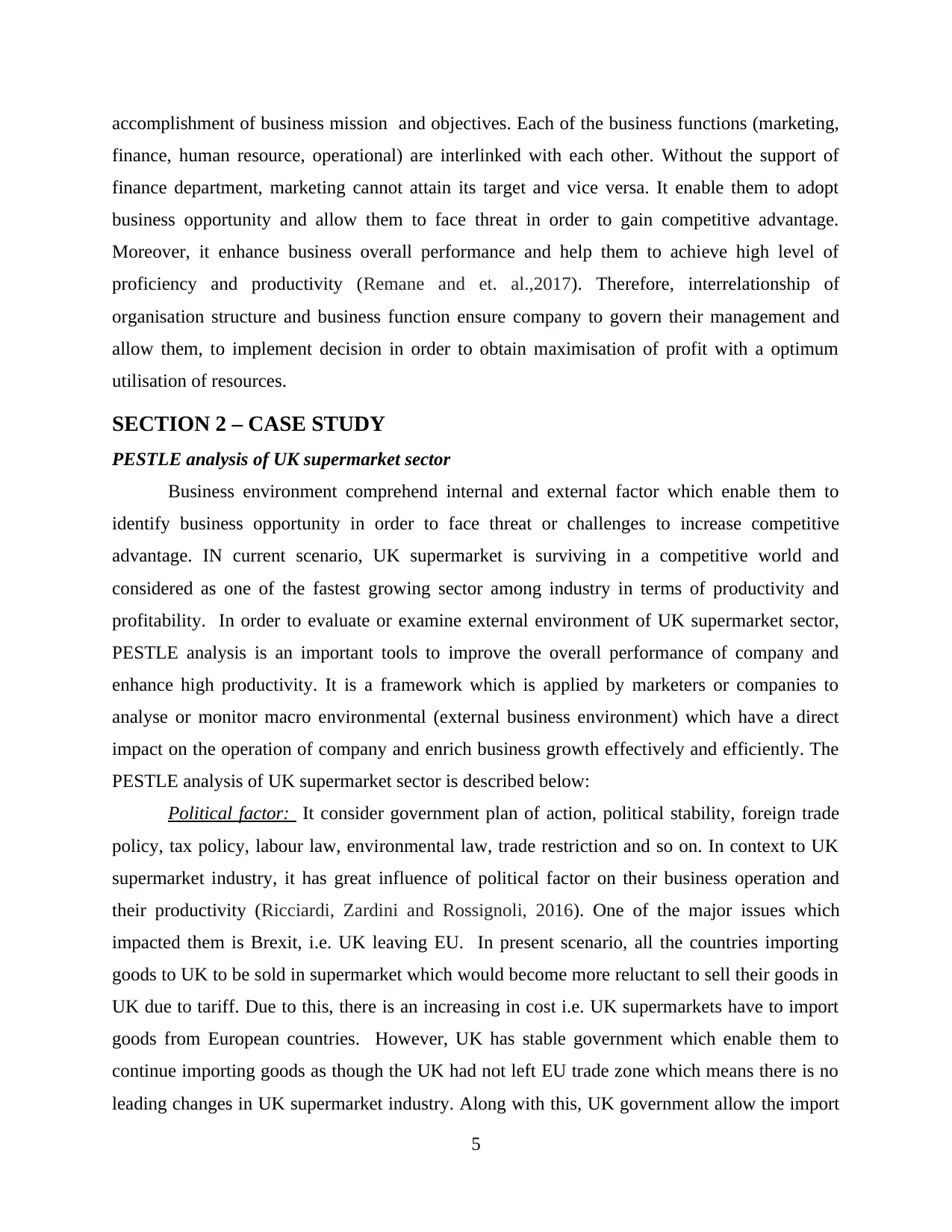
accomplishment of business mission and objectives. Each of the business functions (marketing,
finance, human resource, operational) are interlinked with each other. Without the support of
finance department, marketing cannot attain its target and vice versa. It enable them to adopt
business opportunity and allow them to face threat in order to gain competitive advantage.
Moreover, it enhance business overall performance and help them to achieve high level of
proficiency and productivity (Remane and et. al.,2017). Therefore, interrelationship of
organisation structure and business function ensure company to govern their management and
allow them, to implement decision in order to obtain maximisation of profit with a optimum
utilisation of resources.
SECTION 2 – CASE STUDY
PESTLE analysis of UK supermarket sector
Business environment comprehend internal and external factor which enable them to
identify business opportunity in order to face threat or challenges to increase competitive
advantage. IN current scenario, UK supermarket is surviving in a competitive world and
considered as one of the fastest growing sector among industry in terms of productivity and
profitability. In order to evaluate or examine external environment of UK supermarket sector,
PESTLE analysis is an important tools to improve the overall performance of company and
enhance high productivity. It is a framework which is applied by marketers or companies to
analyse or monitor macro environmental (external business environment) which have a direct
impact on the operation of company and enrich business growth effectively and efficiently. The
PESTLE analysis of UK supermarket sector is described below:
Political factor: It consider government plan of action, political stability, foreign trade
policy, tax policy, labour law, environmental law, trade restriction and so on. In context to UK
supermarket industry, it has great influence of political factor on their business operation and
their productivity (Ricciardi, Zardini and Rossignoli, 2016). One of the major issues which
impacted them is Brexit, i.e. UK leaving EU. In present scenario, all the countries importing
goods to UK to be sold in supermarket which would become more reluctant to sell their goods in
UK due to tariff. Due to this, there is an increasing in cost i.e. UK supermarkets have to import
goods from European countries. However, UK has stable government which enable them to
continue importing goods as though the UK had not left EU trade zone which means there is no
leading changes in UK supermarket industry. Along with this, UK government allow the import
5
finance, human resource, operational) are interlinked with each other. Without the support of
finance department, marketing cannot attain its target and vice versa. It enable them to adopt
business opportunity and allow them to face threat in order to gain competitive advantage.
Moreover, it enhance business overall performance and help them to achieve high level of
proficiency and productivity (Remane and et. al.,2017). Therefore, interrelationship of
organisation structure and business function ensure company to govern their management and
allow them, to implement decision in order to obtain maximisation of profit with a optimum
utilisation of resources.
SECTION 2 – CASE STUDY
PESTLE analysis of UK supermarket sector
Business environment comprehend internal and external factor which enable them to
identify business opportunity in order to face threat or challenges to increase competitive
advantage. IN current scenario, UK supermarket is surviving in a competitive world and
considered as one of the fastest growing sector among industry in terms of productivity and
profitability. In order to evaluate or examine external environment of UK supermarket sector,
PESTLE analysis is an important tools to improve the overall performance of company and
enhance high productivity. It is a framework which is applied by marketers or companies to
analyse or monitor macro environmental (external business environment) which have a direct
impact on the operation of company and enrich business growth effectively and efficiently. The
PESTLE analysis of UK supermarket sector is described below:
Political factor: It consider government plan of action, political stability, foreign trade
policy, tax policy, labour law, environmental law, trade restriction and so on. In context to UK
supermarket industry, it has great influence of political factor on their business operation and
their productivity (Ricciardi, Zardini and Rossignoli, 2016). One of the major issues which
impacted them is Brexit, i.e. UK leaving EU. In present scenario, all the countries importing
goods to UK to be sold in supermarket which would become more reluctant to sell their goods in
UK due to tariff. Due to this, there is an increasing in cost i.e. UK supermarkets have to import
goods from European countries. However, UK has stable government which enable them to
continue importing goods as though the UK had not left EU trade zone which means there is no
leading changes in UK supermarket industry. Along with this, UK government allow the import
5
Paraphrase This Document
Need a fresh take? Get an instant paraphrase of this document with our AI Paraphraser
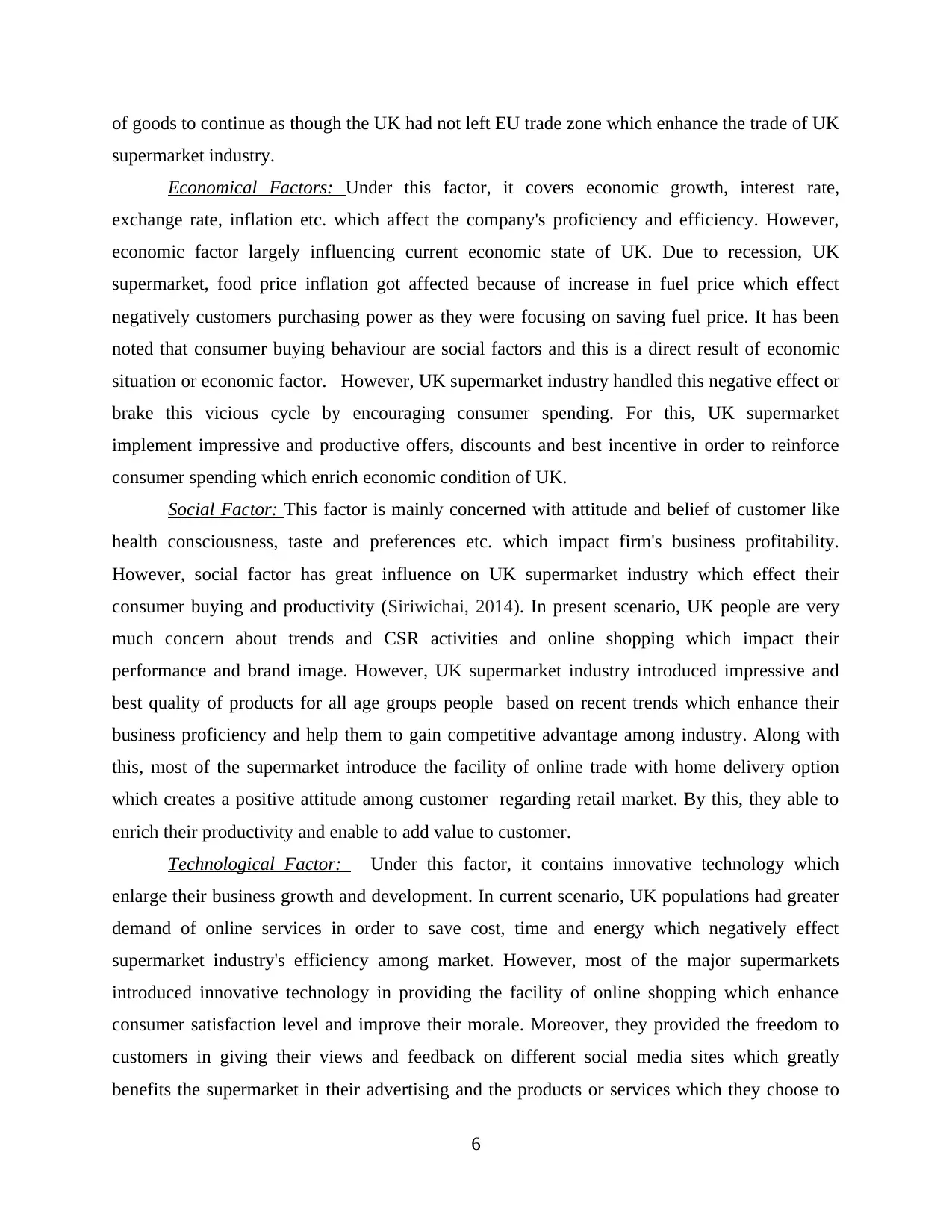
of goods to continue as though the UK had not left EU trade zone which enhance the trade of UK
supermarket industry.
Economical Factors: Under this factor, it covers economic growth, interest rate,
exchange rate, inflation etc. which affect the company's proficiency and efficiency. However,
economic factor largely influencing current economic state of UK. Due to recession, UK
supermarket, food price inflation got affected because of increase in fuel price which effect
negatively customers purchasing power as they were focusing on saving fuel price. It has been
noted that consumer buying behaviour are social factors and this is a direct result of economic
situation or economic factor. However, UK supermarket industry handled this negative effect or
brake this vicious cycle by encouraging consumer spending. For this, UK supermarket
implement impressive and productive offers, discounts and best incentive in order to reinforce
consumer spending which enrich economic condition of UK.
Social Factor: This factor is mainly concerned with attitude and belief of customer like
health consciousness, taste and preferences etc. which impact firm's business profitability.
However, social factor has great influence on UK supermarket industry which effect their
consumer buying and productivity (Siriwichai, 2014). In present scenario, UK people are very
much concern about trends and CSR activities and online shopping which impact their
performance and brand image. However, UK supermarket industry introduced impressive and
best quality of products for all age groups people based on recent trends which enhance their
business proficiency and help them to gain competitive advantage among industry. Along with
this, most of the supermarket introduce the facility of online trade with home delivery option
which creates a positive attitude among customer regarding retail market. By this, they able to
enrich their productivity and enable to add value to customer.
Technological Factor: Under this factor, it contains innovative technology which
enlarge their business growth and development. In current scenario, UK populations had greater
demand of online services in order to save cost, time and energy which negatively effect
supermarket industry's efficiency among market. However, most of the major supermarkets
introduced innovative technology in providing the facility of online shopping which enhance
consumer satisfaction level and improve their morale. Moreover, they provided the freedom to
customers in giving their views and feedback on different social media sites which greatly
benefits the supermarket in their advertising and the products or services which they choose to
6
supermarket industry.
Economical Factors: Under this factor, it covers economic growth, interest rate,
exchange rate, inflation etc. which affect the company's proficiency and efficiency. However,
economic factor largely influencing current economic state of UK. Due to recession, UK
supermarket, food price inflation got affected because of increase in fuel price which effect
negatively customers purchasing power as they were focusing on saving fuel price. It has been
noted that consumer buying behaviour are social factors and this is a direct result of economic
situation or economic factor. However, UK supermarket industry handled this negative effect or
brake this vicious cycle by encouraging consumer spending. For this, UK supermarket
implement impressive and productive offers, discounts and best incentive in order to reinforce
consumer spending which enrich economic condition of UK.
Social Factor: This factor is mainly concerned with attitude and belief of customer like
health consciousness, taste and preferences etc. which impact firm's business profitability.
However, social factor has great influence on UK supermarket industry which effect their
consumer buying and productivity (Siriwichai, 2014). In present scenario, UK people are very
much concern about trends and CSR activities and online shopping which impact their
performance and brand image. However, UK supermarket industry introduced impressive and
best quality of products for all age groups people based on recent trends which enhance their
business proficiency and help them to gain competitive advantage among industry. Along with
this, most of the supermarket introduce the facility of online trade with home delivery option
which creates a positive attitude among customer regarding retail market. By this, they able to
enrich their productivity and enable to add value to customer.
Technological Factor: Under this factor, it contains innovative technology which
enlarge their business growth and development. In current scenario, UK populations had greater
demand of online services in order to save cost, time and energy which negatively effect
supermarket industry's efficiency among market. However, most of the major supermarkets
introduced innovative technology in providing the facility of online shopping which enhance
consumer satisfaction level and improve their morale. Moreover, they provided the freedom to
customers in giving their views and feedback on different social media sites which greatly
benefits the supermarket in their advertising and the products or services which they choose to
6
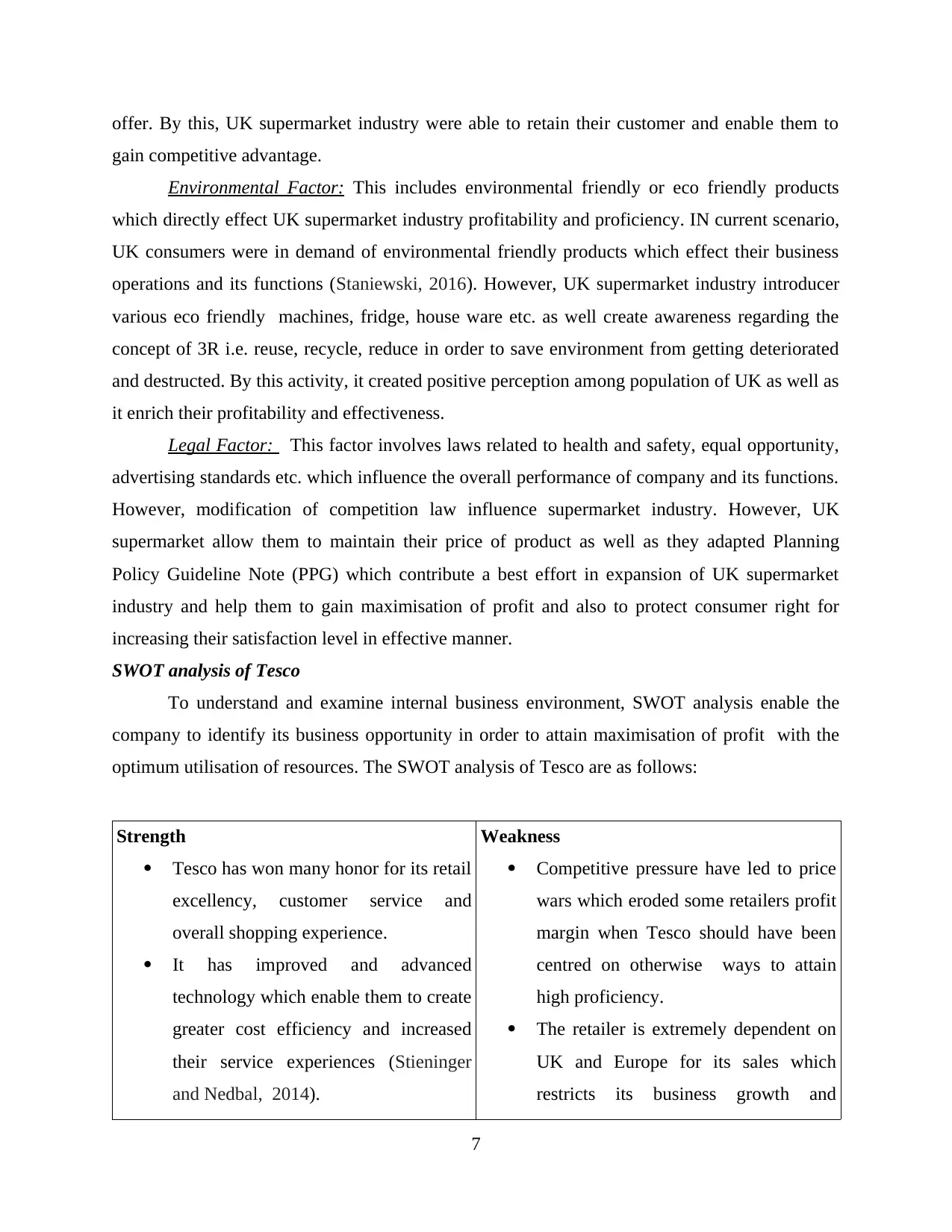
offer. By this, UK supermarket industry were able to retain their customer and enable them to
gain competitive advantage.
Environmental Factor: This includes environmental friendly or eco friendly products
which directly effect UK supermarket industry profitability and proficiency. IN current scenario,
UK consumers were in demand of environmental friendly products which effect their business
operations and its functions (Staniewski, 2016). However, UK supermarket industry introducer
various eco friendly machines, fridge, house ware etc. as well create awareness regarding the
concept of 3R i.e. reuse, recycle, reduce in order to save environment from getting deteriorated
and destructed. By this activity, it created positive perception among population of UK as well as
it enrich their profitability and effectiveness.
Legal Factor: This factor involves laws related to health and safety, equal opportunity,
advertising standards etc. which influence the overall performance of company and its functions.
However, modification of competition law influence supermarket industry. However, UK
supermarket allow them to maintain their price of product as well as they adapted Planning
Policy Guideline Note (PPG) which contribute a best effort in expansion of UK supermarket
industry and help them to gain maximisation of profit and also to protect consumer right for
increasing their satisfaction level in effective manner.
SWOT analysis of Tesco
To understand and examine internal business environment, SWOT analysis enable the
company to identify its business opportunity in order to attain maximisation of profit with the
optimum utilisation of resources. The SWOT analysis of Tesco are as follows:
Strength
Tesco has won many honor for its retail
excellency, customer service and
overall shopping experience.
It has improved and advanced
technology which enable them to create
greater cost efficiency and increased
their service experiences (Stieninger
and Nedbal, 2014).
Weakness
Competitive pressure have led to price
wars which eroded some retailers profit
margin when Tesco should have been
centred on otherwise ways to attain
high proficiency.
The retailer is extremely dependent on
UK and Europe for its sales which
restricts its business growth and
7
gain competitive advantage.
Environmental Factor: This includes environmental friendly or eco friendly products
which directly effect UK supermarket industry profitability and proficiency. IN current scenario,
UK consumers were in demand of environmental friendly products which effect their business
operations and its functions (Staniewski, 2016). However, UK supermarket industry introducer
various eco friendly machines, fridge, house ware etc. as well create awareness regarding the
concept of 3R i.e. reuse, recycle, reduce in order to save environment from getting deteriorated
and destructed. By this activity, it created positive perception among population of UK as well as
it enrich their profitability and effectiveness.
Legal Factor: This factor involves laws related to health and safety, equal opportunity,
advertising standards etc. which influence the overall performance of company and its functions.
However, modification of competition law influence supermarket industry. However, UK
supermarket allow them to maintain their price of product as well as they adapted Planning
Policy Guideline Note (PPG) which contribute a best effort in expansion of UK supermarket
industry and help them to gain maximisation of profit and also to protect consumer right for
increasing their satisfaction level in effective manner.
SWOT analysis of Tesco
To understand and examine internal business environment, SWOT analysis enable the
company to identify its business opportunity in order to attain maximisation of profit with the
optimum utilisation of resources. The SWOT analysis of Tesco are as follows:
Strength
Tesco has won many honor for its retail
excellency, customer service and
overall shopping experience.
It has improved and advanced
technology which enable them to create
greater cost efficiency and increased
their service experiences (Stieninger
and Nedbal, 2014).
Weakness
Competitive pressure have led to price
wars which eroded some retailers profit
margin when Tesco should have been
centred on otherwise ways to attain
high proficiency.
The retailer is extremely dependent on
UK and Europe for its sales which
restricts its business growth and
7
⊘ This is a preview!⊘
Do you want full access?
Subscribe today to unlock all pages.

Trusted by 1+ million students worldwide
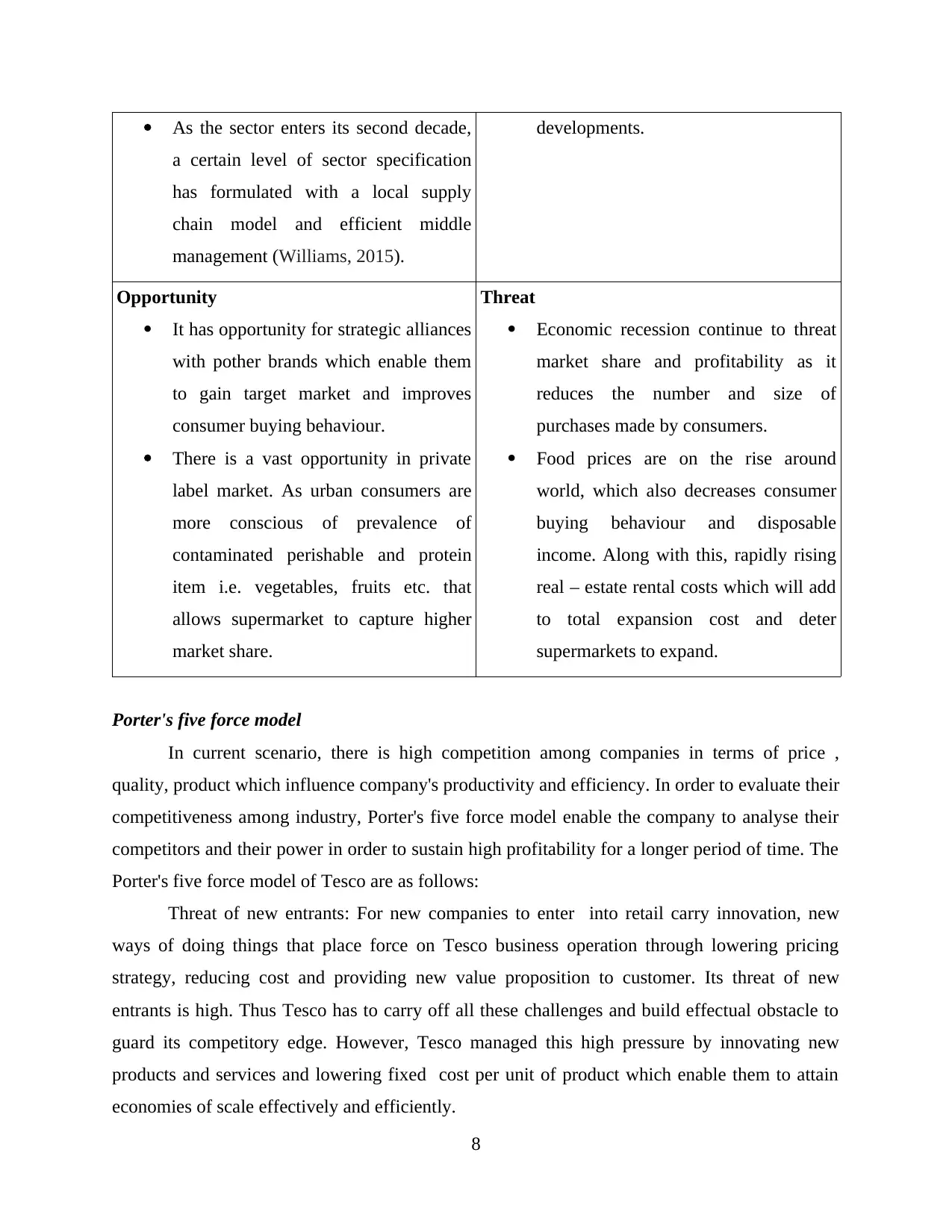
As the sector enters its second decade,
a certain level of sector specification
has formulated with a local supply
chain model and efficient middle
management (Williams, 2015).
developments.
Opportunity
It has opportunity for strategic alliances
with pother brands which enable them
to gain target market and improves
consumer buying behaviour.
There is a vast opportunity in private
label market. As urban consumers are
more conscious of prevalence of
contaminated perishable and protein
item i.e. vegetables, fruits etc. that
allows supermarket to capture higher
market share.
Threat
Economic recession continue to threat
market share and profitability as it
reduces the number and size of
purchases made by consumers.
Food prices are on the rise around
world, which also decreases consumer
buying behaviour and disposable
income. Along with this, rapidly rising
real – estate rental costs which will add
to total expansion cost and deter
supermarkets to expand.
Porter's five force model
In current scenario, there is high competition among companies in terms of price ,
quality, product which influence company's productivity and efficiency. In order to evaluate their
competitiveness among industry, Porter's five force model enable the company to analyse their
competitors and their power in order to sustain high profitability for a longer period of time. The
Porter's five force model of Tesco are as follows:
Threat of new entrants: For new companies to enter into retail carry innovation, new
ways of doing things that place force on Tesco business operation through lowering pricing
strategy, reducing cost and providing new value proposition to customer. Its threat of new
entrants is high. Thus Tesco has to carry off all these challenges and build effectual obstacle to
guard its competitory edge. However, Tesco managed this high pressure by innovating new
products and services and lowering fixed cost per unit of product which enable them to attain
economies of scale effectively and efficiently.
8
a certain level of sector specification
has formulated with a local supply
chain model and efficient middle
management (Williams, 2015).
developments.
Opportunity
It has opportunity for strategic alliances
with pother brands which enable them
to gain target market and improves
consumer buying behaviour.
There is a vast opportunity in private
label market. As urban consumers are
more conscious of prevalence of
contaminated perishable and protein
item i.e. vegetables, fruits etc. that
allows supermarket to capture higher
market share.
Threat
Economic recession continue to threat
market share and profitability as it
reduces the number and size of
purchases made by consumers.
Food prices are on the rise around
world, which also decreases consumer
buying behaviour and disposable
income. Along with this, rapidly rising
real – estate rental costs which will add
to total expansion cost and deter
supermarkets to expand.
Porter's five force model
In current scenario, there is high competition among companies in terms of price ,
quality, product which influence company's productivity and efficiency. In order to evaluate their
competitiveness among industry, Porter's five force model enable the company to analyse their
competitors and their power in order to sustain high profitability for a longer period of time. The
Porter's five force model of Tesco are as follows:
Threat of new entrants: For new companies to enter into retail carry innovation, new
ways of doing things that place force on Tesco business operation through lowering pricing
strategy, reducing cost and providing new value proposition to customer. Its threat of new
entrants is high. Thus Tesco has to carry off all these challenges and build effectual obstacle to
guard its competitory edge. However, Tesco managed this high pressure by innovating new
products and services and lowering fixed cost per unit of product which enable them to attain
economies of scale effectively and efficiently.
8
Paraphrase This Document
Need a fresh take? Get an instant paraphrase of this document with our AI Paraphraser
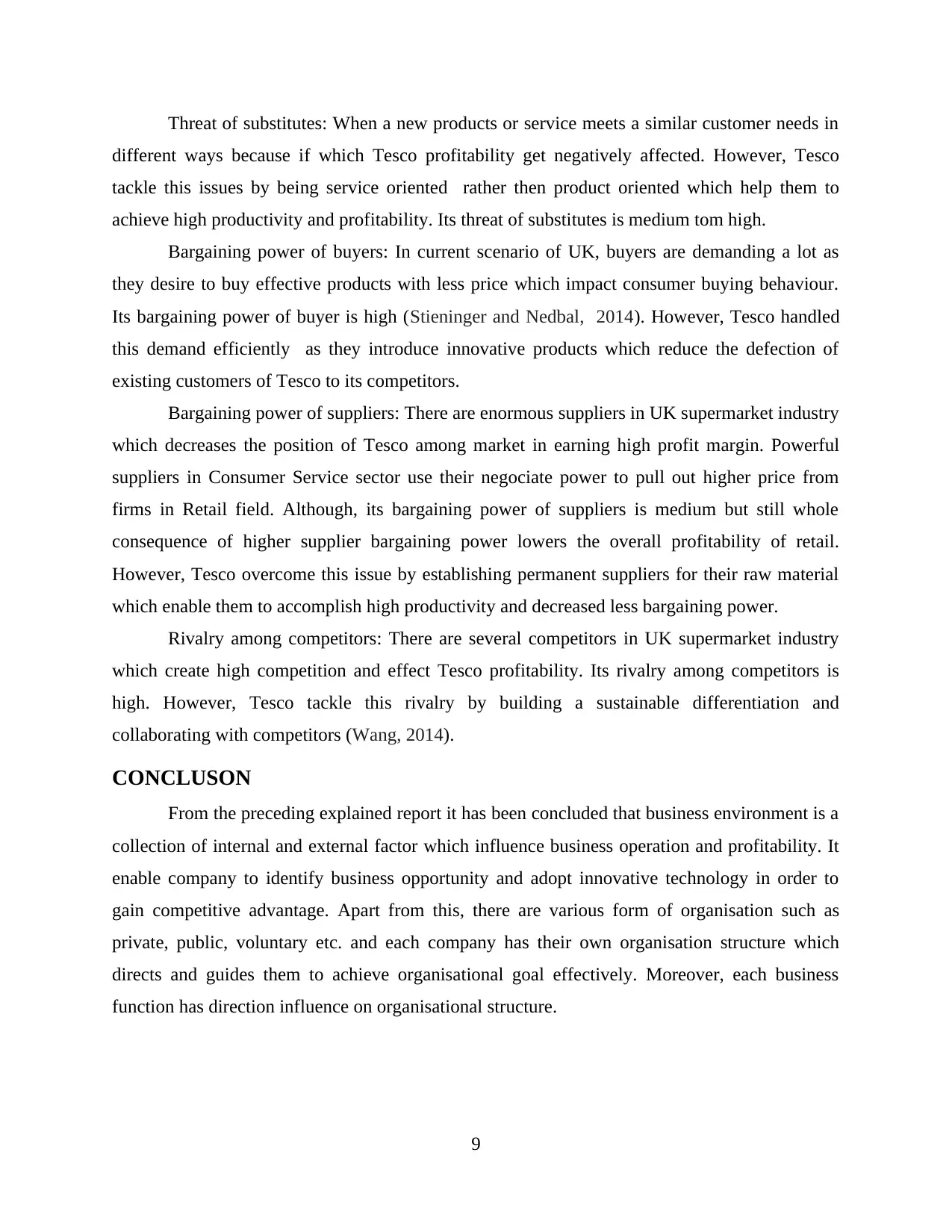
Threat of substitutes: When a new products or service meets a similar customer needs in
different ways because if which Tesco profitability get negatively affected. However, Tesco
tackle this issues by being service oriented rather then product oriented which help them to
achieve high productivity and profitability. Its threat of substitutes is medium tom high.
Bargaining power of buyers: In current scenario of UK, buyers are demanding a lot as
they desire to buy effective products with less price which impact consumer buying behaviour.
Its bargaining power of buyer is high (Stieninger and Nedbal, 2014). However, Tesco handled
this demand efficiently as they introduce innovative products which reduce the defection of
existing customers of Tesco to its competitors.
Bargaining power of suppliers: There are enormous suppliers in UK supermarket industry
which decreases the position of Tesco among market in earning high profit margin. Powerful
suppliers in Consumer Service sector use their negociate power to pull out higher price from
firms in Retail field. Although, its bargaining power of suppliers is medium but still whole
consequence of higher supplier bargaining power lowers the overall profitability of retail.
However, Tesco overcome this issue by establishing permanent suppliers for their raw material
which enable them to accomplish high productivity and decreased less bargaining power.
Rivalry among competitors: There are several competitors in UK supermarket industry
which create high competition and effect Tesco profitability. Its rivalry among competitors is
high. However, Tesco tackle this rivalry by building a sustainable differentiation and
collaborating with competitors (Wang, 2014).
CONCLUSON
From the preceding explained report it has been concluded that business environment is a
collection of internal and external factor which influence business operation and profitability. It
enable company to identify business opportunity and adopt innovative technology in order to
gain competitive advantage. Apart from this, there are various form of organisation such as
private, public, voluntary etc. and each company has their own organisation structure which
directs and guides them to achieve organisational goal effectively. Moreover, each business
function has direction influence on organisational structure.
9
different ways because if which Tesco profitability get negatively affected. However, Tesco
tackle this issues by being service oriented rather then product oriented which help them to
achieve high productivity and profitability. Its threat of substitutes is medium tom high.
Bargaining power of buyers: In current scenario of UK, buyers are demanding a lot as
they desire to buy effective products with less price which impact consumer buying behaviour.
Its bargaining power of buyer is high (Stieninger and Nedbal, 2014). However, Tesco handled
this demand efficiently as they introduce innovative products which reduce the defection of
existing customers of Tesco to its competitors.
Bargaining power of suppliers: There are enormous suppliers in UK supermarket industry
which decreases the position of Tesco among market in earning high profit margin. Powerful
suppliers in Consumer Service sector use their negociate power to pull out higher price from
firms in Retail field. Although, its bargaining power of suppliers is medium but still whole
consequence of higher supplier bargaining power lowers the overall profitability of retail.
However, Tesco overcome this issue by establishing permanent suppliers for their raw material
which enable them to accomplish high productivity and decreased less bargaining power.
Rivalry among competitors: There are several competitors in UK supermarket industry
which create high competition and effect Tesco profitability. Its rivalry among competitors is
high. However, Tesco tackle this rivalry by building a sustainable differentiation and
collaborating with competitors (Wang, 2014).
CONCLUSON
From the preceding explained report it has been concluded that business environment is a
collection of internal and external factor which influence business operation and profitability. It
enable company to identify business opportunity and adopt innovative technology in order to
gain competitive advantage. Apart from this, there are various form of organisation such as
private, public, voluntary etc. and each company has their own organisation structure which
directs and guides them to achieve organisational goal effectively. Moreover, each business
function has direction influence on organisational structure.
9
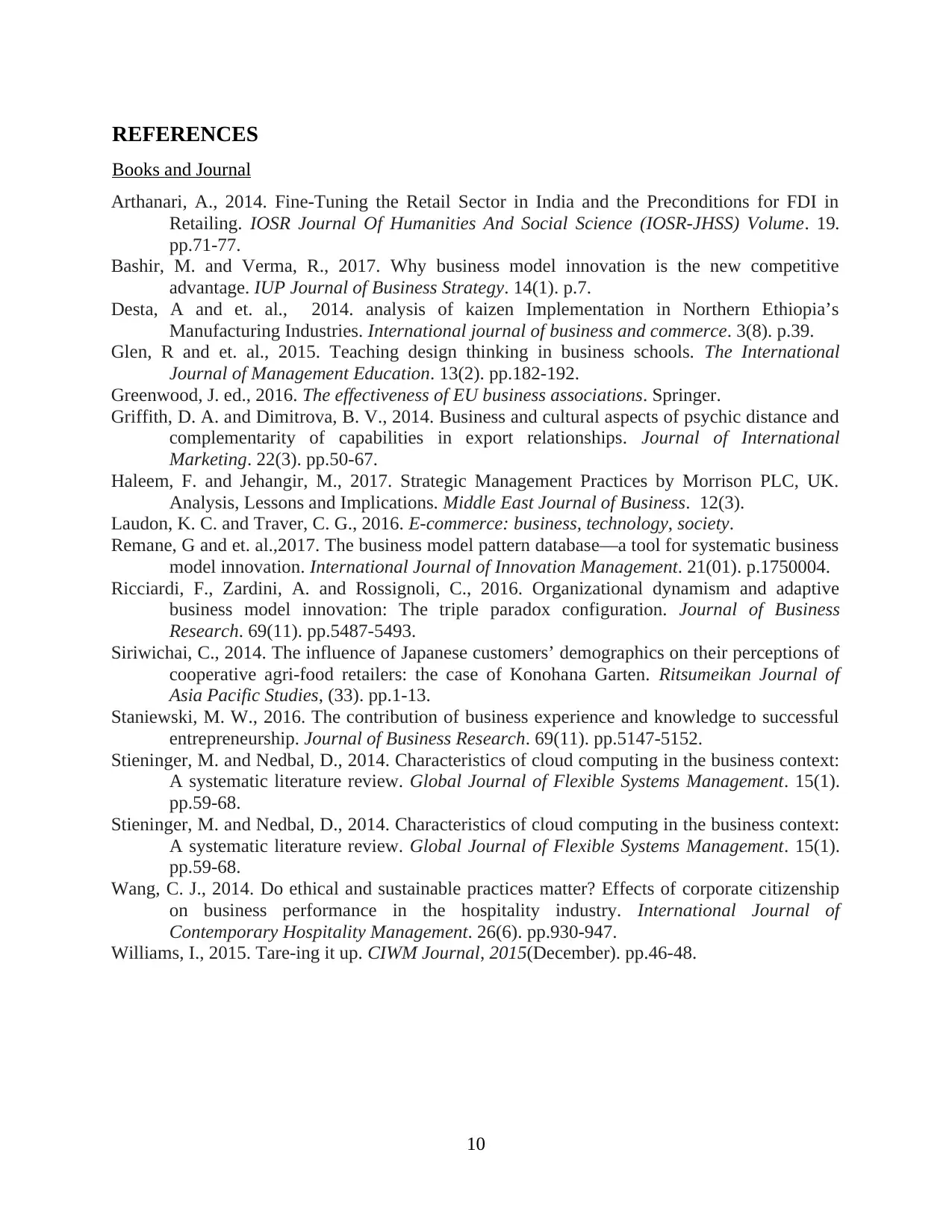
REFERENCES
Books and Journal
Arthanari, A., 2014. Fine-Tuning the Retail Sector in India and the Preconditions for FDI in
Retailing. IOSR Journal Of Humanities And Social Science (IOSR-JHSS) Volume. 19.
pp.71-77.
Bashir, M. and Verma, R., 2017. Why business model innovation is the new competitive
advantage. IUP Journal of Business Strategy. 14(1). p.7.
Desta, A and et. al., 2014. analysis of kaizen Implementation in Northern Ethiopia’s
Manufacturing Industries. International journal of business and commerce. 3(8). p.39.
Glen, R and et. al., 2015. Teaching design thinking in business schools. The International
Journal of Management Education. 13(2). pp.182-192.
Greenwood, J. ed., 2016. The effectiveness of EU business associations. Springer.
Griffith, D. A. and Dimitrova, B. V., 2014. Business and cultural aspects of psychic distance and
complementarity of capabilities in export relationships. Journal of International
Marketing. 22(3). pp.50-67.
Haleem, F. and Jehangir, M., 2017. Strategic Management Practices by Morrison PLC, UK.
Analysis, Lessons and Implications. Middle East Journal of Business. 12(3).
Laudon, K. C. and Traver, C. G., 2016. E-commerce: business, technology, society.
Remane, G and et. al.,2017. The business model pattern database—a tool for systematic business
model innovation. International Journal of Innovation Management. 21(01). p.1750004.
Ricciardi, F., Zardini, A. and Rossignoli, C., 2016. Organizational dynamism and adaptive
business model innovation: The triple paradox configuration. Journal of Business
Research. 69(11). pp.5487-5493.
Siriwichai, C., 2014. The influence of Japanese customers’ demographics on their perceptions of
cooperative agri-food retailers: the case of Konohana Garten. Ritsumeikan Journal of
Asia Pacific Studies, (33). pp.1-13.
Staniewski, M. W., 2016. The contribution of business experience and knowledge to successful
entrepreneurship. Journal of Business Research. 69(11). pp.5147-5152.
Stieninger, M. and Nedbal, D., 2014. Characteristics of cloud computing in the business context:
A systematic literature review. Global Journal of Flexible Systems Management. 15(1).
pp.59-68.
Stieninger, M. and Nedbal, D., 2014. Characteristics of cloud computing in the business context:
A systematic literature review. Global Journal of Flexible Systems Management. 15(1).
pp.59-68.
Wang, C. J., 2014. Do ethical and sustainable practices matter? Effects of corporate citizenship
on business performance in the hospitality industry. International Journal of
Contemporary Hospitality Management. 26(6). pp.930-947.
Williams, I., 2015. Tare-ing it up. CIWM Journal, 2015(December). pp.46-48.
10
Books and Journal
Arthanari, A., 2014. Fine-Tuning the Retail Sector in India and the Preconditions for FDI in
Retailing. IOSR Journal Of Humanities And Social Science (IOSR-JHSS) Volume. 19.
pp.71-77.
Bashir, M. and Verma, R., 2017. Why business model innovation is the new competitive
advantage. IUP Journal of Business Strategy. 14(1). p.7.
Desta, A and et. al., 2014. analysis of kaizen Implementation in Northern Ethiopia’s
Manufacturing Industries. International journal of business and commerce. 3(8). p.39.
Glen, R and et. al., 2015. Teaching design thinking in business schools. The International
Journal of Management Education. 13(2). pp.182-192.
Greenwood, J. ed., 2016. The effectiveness of EU business associations. Springer.
Griffith, D. A. and Dimitrova, B. V., 2014. Business and cultural aspects of psychic distance and
complementarity of capabilities in export relationships. Journal of International
Marketing. 22(3). pp.50-67.
Haleem, F. and Jehangir, M., 2017. Strategic Management Practices by Morrison PLC, UK.
Analysis, Lessons and Implications. Middle East Journal of Business. 12(3).
Laudon, K. C. and Traver, C. G., 2016. E-commerce: business, technology, society.
Remane, G and et. al.,2017. The business model pattern database—a tool for systematic business
model innovation. International Journal of Innovation Management. 21(01). p.1750004.
Ricciardi, F., Zardini, A. and Rossignoli, C., 2016. Organizational dynamism and adaptive
business model innovation: The triple paradox configuration. Journal of Business
Research. 69(11). pp.5487-5493.
Siriwichai, C., 2014. The influence of Japanese customers’ demographics on their perceptions of
cooperative agri-food retailers: the case of Konohana Garten. Ritsumeikan Journal of
Asia Pacific Studies, (33). pp.1-13.
Staniewski, M. W., 2016. The contribution of business experience and knowledge to successful
entrepreneurship. Journal of Business Research. 69(11). pp.5147-5152.
Stieninger, M. and Nedbal, D., 2014. Characteristics of cloud computing in the business context:
A systematic literature review. Global Journal of Flexible Systems Management. 15(1).
pp.59-68.
Stieninger, M. and Nedbal, D., 2014. Characteristics of cloud computing in the business context:
A systematic literature review. Global Journal of Flexible Systems Management. 15(1).
pp.59-68.
Wang, C. J., 2014. Do ethical and sustainable practices matter? Effects of corporate citizenship
on business performance in the hospitality industry. International Journal of
Contemporary Hospitality Management. 26(6). pp.930-947.
Williams, I., 2015. Tare-ing it up. CIWM Journal, 2015(December). pp.46-48.
10
⊘ This is a preview!⊘
Do you want full access?
Subscribe today to unlock all pages.

Trusted by 1+ million students worldwide
1 out of 12